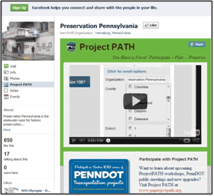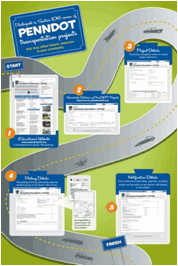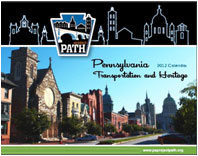PENNSYLVANIA DEPARTMENT OF TRANSPORTATION
AND PRESERVATION PENNSYLVANIA
ProjectPATH
Program Description

Screenshot of ProjectPATH Facebook Page.
(Source: Preservation Pennsylvania.)
Program Benefits
- Pennsylvania DOT (PennDOT) management continues to fully support ProjectPATH, as it has demonstrated time and cost savings in terms of environmental reviews and project delivery.
- The program has increased the opportunities for early consulting party and public participation in the transportation decision-making process. As a result, consulting party and public concerns are identified early in the process, and can be addressed during the preliminary consideration of project alternatives and design.
The Pennsylvania Department of Transportation (PennDOT) and Preservation Pennsylvania partnered to create the “Project for Pennsylvania Transportation and Heritage” (ProjectPATH). Preservation Pennsylvania is a statewide nonprofit organization that assists individuals, organizations, corporations, and government agencies in preservation-related efforts. Through ProjectPath’s on-line platform, Preservation Pennsylvania and PennDOT seek out potential Section 106 consulting parties across the State. The program’s easy to use on-line communication tool links potential consulting parties with PennDOT’s transportation system planning for a given area or areas of the State and to the Section 106 review process associated with projects in those areas.
During system planning, interested parties are able to access on-line documentation for projects programmed in the State Transportation Improvement Program (STIP), as well as project information and historic preservation-related documentation posted by PennDOT’s Cultural Resources Professionals (CRP). Preservation Pennsylvania provides an e-mail alert system to inform interested parties about proposed transportation projects in their communities that have the potential to affect historic properties. The searchable on-line database allows consulting parties and the public to search for a proposed project by location, name, or project number.
Setting Up the Program
Program Elements
- Historic Preservation in Early
Project Development
- Interagency Cooperation
and Collaboration
Work on the program began in April 2009. The first phase involved research and development of the ProjectPATH system. Phase 2 began in December 2010 and involves expansion of the ProjectPATH system, upgrades to the web site, and technical assistance to stakeholders.
The program was fully funded by state monies (i.e., State Highway and Safety Improvement Funding).
Challenges Encountered

ProjectPATH Infographic
(Source: Preservation Pennsylvania.)
Because this program is among the first of its kind, it was difficult to develop a realistic scope of work for creating the program and to operate within the financial constraints of that scope.
In order to contain costs, Preservation Pennsylvania hired subcontractors to complete the database and web site programming. The level of required effort and the nature of the programming obstacles that would be encountered were, however, underestimated.
The ProjectPATH system requires data sharing with PennDOT’s existing project de livery databases. PennDOT’s mandated firewall protections, however, prevented Preservation Pennsylvania from directly assessing PennDOT’s data. Working with PennDOT’s information technology (IT) team, Preservation Pennsylvania developed a protocol to work within PennDOT’s firewall protections.
PennDOT’s IT office did not consider this project a high priority within the Department, so it was never approved for development as an in-house PennDOT program. The project was successful only by establishing a public-private partnership between PennDOT and Preservation Pennsylvania.
Preservation Pennsylvania uses social media to reach out and connect with potential consulting parties and the public. PennDOT, however, has an internal Management Directive issued by the Department’s IT division that places restrictions and required approvals on the use of social media. Resolving this issue is a “work in progress.”
The system currently is unidirectional, meaning that the flow of information is from the CRPs out to consulting parties. In a future upgrade, Preservation Pennsylvania plans to make the discussion more interactive.
The initial roll-out of ProjectPATH led to a misunderstanding concerning the function of the program, which was to foster consultation. ProjectPATH, however, is not a substitute for consultation. This misunderstanding was eventually addressed through outreach and training.
Program Maintenance
The ProjectPATH team consists of a project manager, programmer, graphic designer, and web site hosting and server maintenance provider. The project manager position is full-time, while the programmer, graphic designer, and web site hosting and server maintenance staff requirements are part-time positions.
The ProjectPATH system depends on routine maintenance and upgrades in order to function effectively. Preservation Pennsylvania convenes a quarterly “Stakeholder Meeting” with representatives from PennDOT, SHPO, FHWA, and historic preservation organizations to discuss problems and solutions as they arise.
In general, the ProjectPATH system requires 40-50 hours per month of programming services and 15-20 hours per month of graphic design work. Web site hosting and server maintenance staff services are provided as part of a collocation hosting agreement that provides 48 hours of service per year.
ProjectPATH’s biggest current obstacle is making the program known to the preservation community and the general public. Interest in the program correlates with a community’s level of interest in historic preservation in general.
Critical Factors for a Successful Program

Screenshot of the 2012 ProjectPATH calendar distributed
at workshops and public outreach events.
(Source: Preservation Pennsylvania.)
A good working relationship with historic preservation partners and a commitment to transparency. In addition, a long-term commitment from PennDOT management was critical.
Building a strong partnership with Section 106 stakeholders such as the SHPO, FHWA Division Office, preservation community, etc., based on mutual trust and respect.
Using a nongovernmental agency to partner in the execution of the program.
Engaging IT consultants to lower programming costs.
Ensuring that the program is transparent to stakeholders and the public.
June 1, 2012

